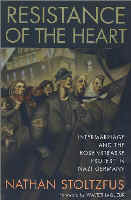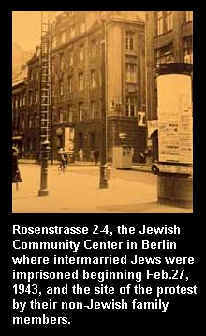 Rosenstrasse:
Rosenstrasse:[Varian Fry Institute] [Chambon Foundation Home] [Chambon Institute Home]
 Rosenstrasse:
Rosenstrasse:
Resistance of the Heart
a onetime Chambon Foundation production
photograph by Abraham Pisarek

The
Chambon Foundation has regretfully abandoned plans for a one-hour documentary based on Resistance of the Heart: Intermarriage and the
Rosenstrasse Protest in Nazi Germany (W. W. Norton, 1996, paperback edition
Rutgers University Press, March
2001), Nathan Stoltzfus’ highly acclaimed study of the
demonstrations in Berlin in 1943 that defied the Gestapo and succeeded in
reversing a planned deportation of Jews.
The effort, led by mainly by
women--non-Jewish spouses in intermarried relationships--hauntingly suggests
that direct challenges to the Final Solution were not necessarily doomed to
failure.
A dozen interviews of Rosenstrasse participants
were videotaped and will be made available in the future for posterity.
In Germany, according to author Stoltzfus, it is commonly believed that it was impossible for Germans to resist the dictatorship in Nazi Germany. This has grown to constitute the ultimate alibi: “What could we have done?”
To be sure, it wasn't easy for an “ordinary person” to stand in the way of the Holocaust. And yet, a little-known street protest in early 1943 shows that German resistance to the deportation of German Jews was not necessarily doomed. Indeed, the gathering on Rosenstrasse—the only known public German protest against the deportation of Jews—stunningly achieved its aims. Ordinary Germans—mostly women, as it happens—stood up to the Third Reich and won!
In
Weapons of the Spirit,
Not Idly By—Peter
Bergson, America and the Holocaust, and the upcoming
And
Crown Thy Good, Pierre Sauvage and the Chambon
Foundation have focused on the few who cared during those terrible times, and
underscored how the actions of French villagers and a few singular Americans
raise the most fundamental questions about individual and national choices
during that turning point in history.
Rosenstrasse:
Resistance of the Heart would have continued and deepened that approach by entering “the belly
of the beast.” Combining
the Chambon Foundation's consistently challenging approach with Stoltzfus’ unparalleled
scholarship on the Rosenstrasse
protest, this documentary such a documentary could convey a new and fundamental understanding of the
nature of German responsibility for the singular evil of the Holocaust,
underscoring the individual responsibility all citizens share in the actions of
their governments.
Among the questions a Rosenstrasse documentary couldl address are the following:
Who were these people who dared to protest against one of history's most ruthless regimes?
What was source of their determination to overcome?
Why did the Nazis “blink”?
Was resistance to the massacre of the Jews indeed possible, even in the heart of Germany?
Could it be that the Nazis did pay scrupulous attention to popular opinion within Germany, contrary to what has often been assumed?
Was the social isolation imposed by fellow Germans on the Jews a major factor in making the Holocaust possible?
What are the timeless implications for citizens of all nations?
The basic facts are simply stated.
Up until early 1943, Jews married to Germans had been exempted from the
death camp deportations. But during
what the Gestapo called the “Final Roundup of Jews,” they too were arrested
and taken to a pre-deportation collection center at Rosenstrasse
2-4, in the heart of Berlin, and the key location for this documentary.
Most of these mixed marriages involved Jewish men married to non-Jewish
women. The German women quickly
discovered this collection center, and began to meet each other there. Soon they
began calling out in one voice, "Give us our husbands back."
As many as 600 or more gathered together that first day, and
as many as 6,000 may have joined in at various times as the protests grew day
after day, for a week. Again and
again, the police scattered the women with threats to shoot them down in the
streets, but each time they advanced again, with increasing solidarity although
they were unarmed, unorganized and leaderless.
It is hard to imagine an act more dangerous for German civilians than an
open confrontation with the Gestapo, on the Gestapo's front doorstep.
Arrest seemed a foregone conclusion.
“Without warning, the guards began setting up machine
guns,” Charlotte Israel recalled. “Then
they directed them at the crowd and shouted: ‘If you don’t go now, we’ll
shoot.’ The movement surged
backward. But then, for the first
time, we really hollered. Now, we
couldn’t care less. They’re
going to shoot in any case, so now we’ll yell too, we thought.
We yelled, ‘Murderer, murderer, murderer, murderer.’”
Joseph Goebbels, in addition to being the influential
Minister for Public Enlightenment and Propaganda, also served as Gauleiter
(Nazi Party Leader) of Berlin. “There
have been unpleasant scenes,” he noted in his diary. “The people gathered together in large throngs and even sided with the
Jews to some extent.” Astonishingly,
after a week of this, Goebbels suddenly ordered the release of the Jews with
German spouses, for reasons that provide key insights into the nature of the
Nazi regime: nearly 2,000 Jews were
freed—and were allowed to survive till the very end.
Leopold Gutterer, Goebbels’ deputy, told Stoltzfus that Goebbels ordered the Jews’ release “in order to eliminate the protest from the world, so that others didn’t begin to do the same.” Goebbels similarly decided not to arrest the protesting spouses in order to avoid the risk of further unrest from their non-Jewish relatives.
“We acted from the heart,” said one of them, the still
feisty Elsa Holzer. “We wanted to
show that we weren’t willing to let them go. I went to Rosenstrasse every day before work. And there was always a flood of people there.
It wasn’t organized or instigated. Everyone was simply there. Exactly like me.”
Though they are elderly and dwindling in number, there are
still eyewitnesses to tell the story, and Nathan Stoltzfus knows them all and
has already conducted audio-taped interviews with more than two dozen possible
participants in the documentary: women who protested, Jews who were imprisoned
and released, Jewish officials in charge of guarding the collection center.
Stoltzfus, who grew up in a Mennonite home and attended
Harvard Divinity School before becoming a Harvard-trained historian and a
Holocaust scholar, will himself be a major figure in the documentary.
When he began researching the story, there were only a small number of
short, anecdotal reports on the protest, which historians had tended to overlook
as an oddity without significance.
The documentary will be shot mainly in Germany, notably at
such key locations as the
In addition to eyewitness reports and scholarly analysis and
debate, the documentary will draw on photographs, newsreels, documents and
artifacts to visually tell the story: police release certificates for Jews set
free as a result of the protest; photographs of prisoners before and after their
ordeal; a chess board which a prisoner fashioned from a mattress cover, on which
he played with pebbles, to pass the time; pages from the Stürmer
publication, graphically illustrating the identity of half Jews; a report from
the main SS office of economics, announcing the arrival in Auschwitz of 25 Jews
deported from Rosenstrasse—who
twelve days later, following the protest, were returned to Berlin and released!
The documentary
would have aimed to provide the necessary historical
context for the Rosenstrasse protest and its improbable outcome: the German
defeat at Stalingrad, the heavy air attack on Berlin by the Royal Air Force, the
declaration of “Total War” by Goebbels and other top officials just the week
before. Goebbels’ decision will
be explored in terms of Hitler’s theory of power: many viewers will be surprised to realize that in Germany, terror was not
at all the main tool in the Nazi arsenal, though there is, in fact, a growing
consensus about this among historians.
Most movingly perhaps, the documentary
would have probed the
startling and effective loyalty of many Germans married to Jews. The story of the Rosenstrasse
Protest thus begins before that climactic event, with the stories of those who
protested, and how they came to marry Jews. It poignantly demonstrates the
courage—and the compromises—of their self-protective resistance, charting
the lives of intermarried couples in the context of Nazi persecution and social
harassment, as they are drawn slowly closer together, tighter and tighter, until
they meet at Rosenstrasse.
Despite the mounting and intense pressures on all sides, the
overwhelming majority of these mixed marriages continued.
At war’s end, no less than 98 percent of German Jews still alive in
Germany and registered with the police were married to non-Jewish Germans.
There are other examples that successful protest was
possible in Nazi Germany, and the documentary will touch on them, underscoring
that citizens everywhere bear responsibility for the actions of their
governments.
The documentary
would have been designed for a broad P. B. S.
television audience, as was the Chambon Foundation’s very successful first
undertaking, Weapons of the Spirit, which was introduced by Bill Moyers.
While maintaining high historical standards, the film will aim to make its points in ways that will be accessible to
many viewers, drawing on the inherent drama of the events in
question and the bittersweet consolation of the success that was achieved at Rosenstrasse.
The foundation, founded in 1982 by Pierre Sauvage, has
established itself as a growing media resource and archival facility focused on
the Holocaust and especially on its “necessary lessons of hope.”
The Chambon Foundation’s boards include many major historians and other
scholars, and its
projects draw on their expertise and advice.
Comments
on Nathan Stotzfus' Resistance of the Heart
Foreword by Joschka Fischer, then Foreign
Minister of Germany
Back
to Chambon Foundation
documentaries
[Varian Fry Institute] [Chambon Foundation Home] [Chambon Institute]
[email us] [contact information] [table of contents] [make a contribution?] [search] [feedback] [guest book] [link to us?]
© Copyright 2004, Chambon Foundation. All rights reserved. Revised: May 20, 2010